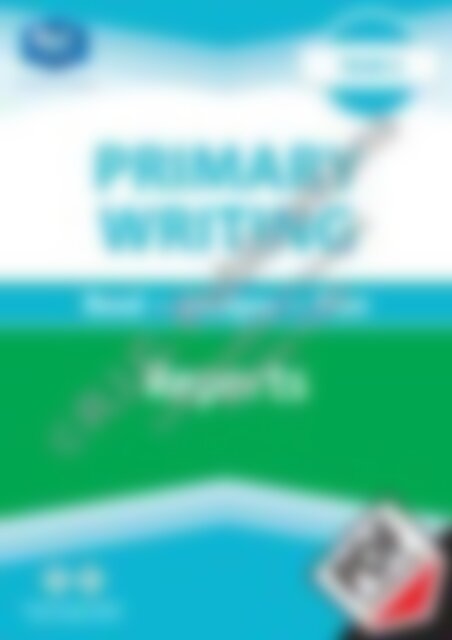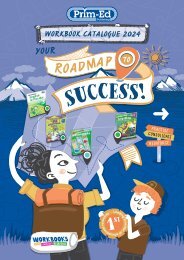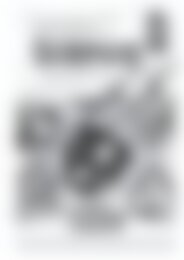RIC-20213 Primary Writing Year 5 – Reports
Create successful ePaper yourself
Turn your PDF publications into a flip-book with our unique Google optimized e-Paper software.
©R.I.C. Publications<br />
Low Resolution Images<br />
Display Copy
PRIMARY WRITING (Book F)<br />
Published by R.I.C. Publications ® 2006<br />
Copyright © R.I.C. Publications ® 2006<br />
This master may only be reproduced by the<br />
original purchaser for use with their class(es). The<br />
publisher prohibits the loaning or onselling of this<br />
master for the purposes of reproduction.<br />
<strong>RIC</strong><strong>–</strong><strong>20213</strong><br />
Copyright Notice<br />
Blackline masters or copy masters are published and<br />
sold with a limited copyright. This copyright allows<br />
publishers to provide teachers and schools with a<br />
wide range of learning activities without copyright<br />
being breached. This limited copyright allows the<br />
purchaser to make sufficient copies for use within<br />
their own education institution. The copyright is not<br />
transferable, nor can it be onsold. Following these<br />
instructions is not essential but will ensure that you,<br />
as the purchaser, have evidence of legal ownership<br />
to the copyright if inspection occurs.<br />
For your added protection in the case of copyright<br />
inspection, please complete the form below. Retain<br />
this form, the complete original document and the<br />
invoice or receipt as proof of purchase.<br />
Name of Purchaser:<br />
Date of Purchase:<br />
Supplier:<br />
School Order# (if applicable):<br />
Signature of Purchaser:<br />
©R.I.C. Publications<br />
Low Resolution Images<br />
Display Copy<br />
Internet websites<br />
In some cases, websites or specific URLs may be recommended. While these are checked and rechecked at the<br />
time of publication, the publisher has no control over any subsequent changes which may be made to webpages.<br />
It is strongly<br />
recommended that the class teacher checks<br />
all<br />
URLs before allowing students to access them.<br />
View all pages online<br />
PO Box 332 Greenwood Western Australia 6924<br />
Website: www.ricgroup.com.au<br />
Email: mail@ricgroup.com.au
<strong>Primary</strong> writing<br />
BOOK F<br />
Foreword<br />
<strong>Primary</strong> writing<br />
is a series of seven books designed to provide opportunities for<br />
students to read, examine and write a variety of text types; narratives, recounts,<br />
procedures, reports, explanations and expositions.<br />
Contents<br />
Titles in this series:<br />
• <strong>Primary</strong> writing<br />
Book A<br />
• <strong>Primary</strong> writing<br />
Book B<br />
• <strong>Primary</strong> writing<br />
Book C<br />
• <strong>Primary</strong> writing<br />
Book D<br />
•<br />
<strong>Primary</strong> writing<br />
Book E<br />
•<br />
<strong>Primary</strong> writing<br />
Book F<br />
•<br />
<strong>Primary</strong> writing<br />
Book G<br />
Teachers notes .......................................................................................iv <strong>–</strong> v<br />
Curriculum links ............................................................................................ v<br />
<strong>Writing</strong> format information ....................................................................vi <strong>–</strong> vii<br />
<strong>Writing</strong> format checklists .....................................................................viii <strong>–</strong> xiii<br />
Blank writing formats ......................................................................... xiv <strong>–</strong> xix<br />
Proofreading and editing checklist ............................................................. xx<br />
Class recording sheet .................................................................................xxi<br />
Narratives ................................................................................................................2<strong>–</strong>13<br />
1 <strong>–</strong> Resistance ......................................................................................... 2<strong>–</strong>5<br />
2 <strong>–</strong> Accidental find ................................................................................... 6<strong>–</strong>9<br />
3 <strong>–</strong> Costume drama ............................................................................. 10<strong>–</strong>13<br />
Recounts ..............................................................................................................14<strong>–</strong>25<br />
1 <strong>–</strong> A very strange creature .................................................................. 14<strong>–</strong>17<br />
2 <strong>–</strong> Email to Dylan ................................................................................ 18<strong>–</strong>21<br />
3 <strong>–</strong> The journal of a Chinese gold digger ..............................................22<strong>–</strong>25<br />
Procedures ..............................................................................................................26<strong>–</strong>37<br />
1 <strong>–</strong> Baked lemon and ginger snapper ..................................................26<strong>–</strong>29<br />
2 <strong>–</strong> Ladybirds ........................................................................................30<strong>–</strong>33<br />
3 <strong>–</strong> Battleships ..................................................................................... 34<strong>–</strong>37<br />
<strong>Reports</strong> ..............................................................................................................38<strong>–</strong>49<br />
©R.I.C. Publications<br />
Low Resolution Images<br />
Display Copy<br />
1 <strong>–</strong> Problems with plastic ..................................................................... 38<strong>–</strong>41<br />
2 <strong>–</strong> The circulatory system ................................................................... 42<strong>–</strong>45<br />
3 <strong>–</strong> Antarctic experience ...................................................................... 46<strong>–</strong>49<br />
Explanations ..............................................................................................................50<strong>–</strong>61<br />
1 <strong>–</strong> The human voice ........................................................................... 50<strong>–</strong>53<br />
2 <strong>–</strong> Compact discs ............................................................................... 54<strong>–</strong>57<br />
3 <strong>–</strong> Peckish plants ............................................................................... 58<strong>–</strong>61<br />
Expositions ..............................................................................................................62<strong>–</strong>73<br />
1 <strong>–</strong> Class captain ................................................................................. 62<strong>–</strong>65<br />
2 <strong>–</strong> Riverside Park ............................................................................... 66<strong>–</strong>69<br />
3 <strong>–</strong> Jumping Jiminy! What a journal! .................................................... 70<strong>–</strong>73<br />
PRIMARY WRITING<br />
R.I.C. Publications<br />
www.ricgroup.com.au<br />
iii
<strong>Writing</strong> format information<br />
Below are general descriptions of the text types included in this book.<br />
Report<br />
<strong>–</strong> is a framework which describes aspects of a<br />
living or non-living thing in detail<br />
<strong>–</strong> includes:<br />
• Title<br />
• Classification: a general or classifying<br />
statement<br />
• Description: accurate and detailed<br />
• Conclusion: a comment about the content<br />
of the report (optional)<br />
<strong>–</strong> uses the following language features:<br />
• factual language rather than imaginative<br />
• the third person<br />
• the timeless present tense<br />
• information organised into paragraphs<br />
A report may be written in the form of a book<br />
review, scientifi c report, newspaper or magazine<br />
article, eyewitness account or a progress report.<br />
Recount<br />
<strong>–</strong> is a framework which retells events as they<br />
happened in time order<br />
<strong>–</strong> may be factual, personal or imaginative<br />
<strong>–</strong> includes:<br />
• Title<br />
• Orientation: all relevant background (who,<br />
when, where, why)<br />
• Events: signifi cant events in detail<br />
• Conclusion: often with an evaluative<br />
comment<br />
<strong>–</strong> uses the following language features:<br />
• vocabulary to suggest time passing<br />
• paragraphs to show separate sections<br />
• the past tense<br />
A recount may be written in the form of<br />
a newspaper report, diary, letter, journal,<br />
eyewitness account, biography, autobiography or<br />
history.<br />
Narrative<br />
<strong>–</strong> is a framework which tells a story<br />
<strong>–</strong> includes:<br />
• Title<br />
• Orientation: the setting, time and characters<br />
• Complication: involving the main character(s)<br />
and a sequence of events<br />
• Resolution: to the complication<br />
• Conclusion: often showing what has<br />
changed and what the characters have learnt<br />
<strong>–</strong> uses the following language features:<br />
• a range of conjunctions to connect ideas<br />
• appropriate paragraphing<br />
• descriptive language<br />
• usually written in past tense<br />
A narrative may be written in the form of a poem,<br />
story, play, imaginative story, fairytale, novel, myth,<br />
legend, ballad, science fi ction story or modern<br />
fantasy.<br />
Procedure<br />
<strong>–</strong> is a framework which outlines how something is<br />
made or done<br />
<strong>–</strong> includes:<br />
• Title<br />
• Goal: the purpose of the procedure shown<br />
clearly and precisely<br />
• Materials: a list of materials or requirements<br />
under appropriate headings or layout<br />
• Steps: the method in a detailed, logical<br />
sequence<br />
©R.I.C. Publications<br />
Low Resolution Images<br />
Display Copy<br />
• Test: an evaluation (if appropriate)<br />
<strong>–</strong> uses the following language features:<br />
• instructions often with an imperative verb<br />
• subject-specifi c vocabulary<br />
• simple present tense<br />
• concise language<br />
A procedure may be written in the form of a recipe,<br />
instructions for making something, an experiment,<br />
an instruction manual, a maths procedure, how to<br />
play a game, how to operate an appliance, how to<br />
use an atlas or how to deal with a problem.<br />
vi<br />
R.I.C. Publications<br />
www.ricgroup.com.au<br />
PRIMARY WRITING
<strong>Writing</strong> format information<br />
Explanation<br />
<strong>–</strong> is a framework which outlines how something occurs,<br />
works or is made<br />
<strong>–</strong> includes:<br />
• Title<br />
• Statement: precisely what is to be explained<br />
• Explanation: a clear account in logical sequence of<br />
how and why the phenomenon occurs<br />
• Conclusion: an evaluation and comment about<br />
what has been explained<br />
OR<br />
• Title<br />
• a definition<br />
• a description of the components or parts<br />
• the operation—how it works or is made<br />
• the application—where and when it works or is<br />
applied<br />
• special features—interesting comments<br />
• evaluation or comment/conclusion<br />
<strong>–</strong> uses the following language features:<br />
• subject-specifi c terms and technical vocabulary<br />
where appropriate<br />
• simple present tense is often used<br />
• linking words to show cause and effect<br />
• information is organised into paragraphs<br />
An explanation may be written in the form of an essay, or<br />
a handbook—for example, how a kite works—a science,<br />
health or society and environment text.<br />
Exposition<br />
<strong>–</strong> is a framework which argues for a<br />
particular position and attempts to<br />
persuade the audience to share this<br />
view<br />
<strong>–</strong> includes:<br />
• Title<br />
• Overview: statement of the problem<br />
or issue and the writer’s position<br />
• Arguments: presented in a logical<br />
manner with supporting detail,<br />
usually from the strongest to the<br />
weakest<br />
• Conclusion: a restating of the<br />
writer’s position and a summary of<br />
the arguments presented<br />
<strong>–</strong> uses the following language features:<br />
• a variety of controlling and emotive<br />
words and conjunctions<br />
• paragraphs to state and elaborate on<br />
each point<br />
An exposition may be written in the form<br />
of an essay, a letter, policy statement,<br />
a critical review, an advertisement, an<br />
editorial or a speech.<br />
©R.I.C. Publications<br />
Low Resolution Images<br />
Display Copy<br />
Modelled writing<br />
The role of the teacher is to observe and support students as they develop as writers.<br />
<strong>Writing</strong> is an extremely complex activity, simultaneously involving decisions on content,<br />
text coherence and cohesion, spelling, grammar, punctuation and a sense of audience and<br />
purpose. Because it takes time and practice to develop understanding of the writing process<br />
and the different writing formats, many opportunities for students to interact with their teacher<br />
and their peers are essential.<br />
Modelled writing is an effective way of supporting student writers, particularly when the focus<br />
is on the cognitive processes involved.<br />
Frequent modelling of the planning process and how these plans can be used to write text in<br />
different formats, is strongly recommended.<br />
PRIMARY WRITING<br />
R.I.C. Publications<br />
www.ricgroup.com.au<br />
vii
Proofreading and editing checklist<br />
Name: Date:<br />
Title:<br />
Punctuation:<br />
I have included:<br />
Spelling:<br />
Text type:<br />
capital letters for:<br />
beginning sentences. ..............................................................................................................<br />
proper nouns. ..........................................................................................................................<br />
titles .........................................................................................................................................<br />
question marks. ..................................................................................................................................<br />
full stops. .............................................................................................................................................<br />
commas<br />
in lists . ....................................................................................................................................<br />
for pauses . .............................................................................................................................<br />
to make meaning clear ...........................................................................................................<br />
apostrophes:<br />
for grammatical contractions. ..................................................................................................<br />
to show ownership. .................................................................................................................<br />
exclamation marks. .............................................................................................................................<br />
quotation marks. .................................................................................................................................<br />
colons<br />
in titles ....................................................................................................................................<br />
for offset lists ..........................................................................................................................<br />
brackets .............................................................................................................................................<br />
hyphens .............................................................................................................................................<br />
I have:<br />
checked the spelling of any unknown words. ..........................................................................<br />
not confused words that sound the same. ..............................................................................<br />
used correct endings for plurals. .............................................................................................<br />
Language features:<br />
<strong>Writing</strong>:<br />
I have included:<br />
a variety of different verbs. ......................................................................................................<br />
correct verb tenses. ................................................................................................................<br />
correct verb-subject agreement. .............................................................................................<br />
appropriate adverbs to describe verbs. ...................................................................................<br />
suitable nouns ........................................................................................................................<br />
appropriate pronouns ..............................................................................................................<br />
interesting adjectives ..............................................................................................................<br />
suitable conjunctions ...............................................................................................................<br />
a variety of prepositions ..........................................................................................................<br />
appropriate paragraphing. .......................................................................................................<br />
no double negatives ................................................................................................................<br />
©R.I.C. Publications<br />
Low Resolution Images<br />
Display Copy<br />
I have read through my writing to check that:<br />
it makes sense. .......................................................................................................................<br />
it is easy to understand. ..........................................................................................................<br />
there are no repeated or omitted words. .................................................................................<br />
there are no errors of fact. ......................................................................................................<br />
xx<br />
R.I.C. Publications<br />
www.ricgroup.com.au<br />
PRIMARY WRITING
1 <strong>Reports</strong><br />
TEACHERS NOTES<br />
Structural and language features are shown on the left and right of the text below.<br />
Title<br />
Classification <strong>–</strong><br />
a general statement<br />
about the subject of<br />
the report<br />
Description <strong>–</strong><br />
provides accurate<br />
description and facts<br />
Conclusion <strong>–</strong><br />
a fi nal comment about<br />
the subject of the<br />
report. (It may include<br />
a personal comment<br />
by the writer.)<br />
Problems with plastic<br />
It is estimated that 500 billion to 1 trillion plastic bags are now made and used each<br />
year. Waste plastic, particularly in the form of used plastic shopping bags, causes<br />
immense problems worldwide for both land and marine environments.<br />
The problems they cause in the environment include blocking drainage systems,<br />
creating litter, adding to landfill waste, choking marine life and consuming energy<br />
during the manufacturing process.<br />
Most plastic bags are made from high density polyethylene (HDPE). HDPE is made<br />
from liquefi ed petroleum gas (LPG). The amount of LPG needed to make one plastic<br />
bag would drive a car about 100 metres. An enormous amount of LPG is used to<br />
make the amount of plastic bags the world requires.<br />
Plastic bags decompose at an incredibly slow rate, ranging from 20 to 1000 years.<br />
This means that plastic bags are continuing to accumulate. They may be reused or<br />
recycled, but are not being destroyed.<br />
On land, plastic bags block drains and gutters, stopping the fl ow of rainwater and<br />
sewage, resulting in pollution and threatening natural environments. Land animals<br />
can eat or become trapped in plastic bags. When the animals die, their bodies<br />
naturally decompose at a much quicker rate than the bag. The plastic the animal<br />
swallowed remains in the environment to be swallowed by another animal.<br />
Scientists believe more than 100 000 marine mammals such as seals, whales and<br />
dolphins die each year after being tangled in waste plastic. The plastic becomes<br />
twisted around the animals’ limbs or fi ns, cutting into their fl esh. This slows them down<br />
so they fi nd it diffi cult to catch or eat food and makes them easy prey. Turtles are<br />
thought to mistake fl oating plastic bags for jellyfi sh, their favourite food. The plastic<br />
can choke the turtle or block its stomach so it can not eat.<br />
Birds are attracted to the bright colour of some plastics and eat them. This can choke<br />
or poison the birds. Dead chicks have been found to have plastic in their stomachs.<br />
The parents had been feeding them what they thought was food.<br />
People can help solve this problem in the following ways. They can reduce the use<br />
of plastic bags by using paper or cloth bags, and reuse and recycle plastic bags as<br />
much as possible. People also need to remember that plastic bags put in bins will<br />
eventually end up in landfi ll, potentially at large in the environment.<br />
Teacher information<br />
• Read through the information report with the students and<br />
discuss the features of a report.<br />
• Work through the analysis on page 40 with the class.<br />
Explain that: ‘I’, ‘we’, ‘my’ and ‘our’ are examples of the<br />
first person<br />
‘you’ and ‘your’ are examples of the second<br />
person<br />
‘he’, ‘she’, ‘it’ and ‘they’ are examples of the<br />
third person<br />
For example: I/We take my/our dog for a walk<br />
every morning. (fi rst person)<br />
You take your dog for a walk every morning.<br />
(second person)<br />
Gemma/She takes her dog for a walk every<br />
morning./They take their/the dog for a walk<br />
every morning. (third person)<br />
• Before students attempt to plan and write their own<br />
information report on page 41, model this process with the<br />
whole class, using another issue students are familiar with.<br />
Students will need to have gathered suffi cient information<br />
about the subject of their choice prior to planning their<br />
report.<br />
• Students’ reports could be read out orally by them in small<br />
groups or to the whole class and discussed. (Purpose/<br />
Audience)<br />
• written<br />
in timeless<br />
present<br />
tense; e.g. is<br />
estimated,<br />
causes<br />
• technical<br />
vocabulary<br />
and subjectspecifi<br />
c terms<br />
are used; e.g.<br />
landfill waste,<br />
high density<br />
polyethylene<br />
• uses factual<br />
language<br />
rather than<br />
imaginative;<br />
e.g. ranging<br />
from 20 to<br />
1000 years,<br />
are continuing<br />
to accumulate<br />
• written in the<br />
third person;<br />
e.g. The<br />
plastic, it<br />
• information<br />
is organised<br />
into<br />
paragraphs.<br />
• Published reports, accompanied with appropriate<br />
illustrations or photographs, could be displayed for other<br />
students to read and compare. (Publishing/Display/<br />
Purpose)<br />
• The activity could be done in conjunction with a science,<br />
health or society and environment topic. (Context/Purpose)<br />
Answers<br />
Page 29<br />
1. (a) Problems with plastic<br />
(b) Teacher check<br />
2. Teacher check<br />
3. (a) (i) high density polyethylene<br />
(ii) liquefi ed petroleum gas<br />
(b) Answers will vary but should refl ect the following:<br />
Paragraph 3 <strong>–</strong> The number of plastic bags continues to<br />
accumulate, as they decompose at a very slow rate.<br />
Paragraph 5 <strong>–</strong> It describes the effects plastic bags have<br />
on marine life.<br />
(c) block, stopping, resulting, threatening<br />
(d) Birds are attracted to the bright colours of some plastics<br />
and if they eat them they can choke or be poisoned.<br />
4. Plastic bags put in bins will eventually end up in landfi ll,<br />
potentially at large in the environment.<br />
©R.I.C. Publications<br />
Low Resolution Images<br />
Display Copy<br />
38 R.I.C. Publications www.ricgroup.com.au<br />
PRIMARY WRITING
Report 1<br />
Problems with plastic<br />
It is estimated that 500 billion to 1 trillion plastic bags are now made and used each year. Waste plastic,<br />
particularly in the form of used plastic shopping bags, causes immense problems worldwide for both land and<br />
marine environments.<br />
The problems they cause in the environment include blocking drainage systems, creating litter, adding to landfi ll<br />
waste, choking marine life and consuming energy during the manufacturing process.<br />
Most plastic bags are made from high density<br />
polyethylene (HDPE). HDPE is made from liquefi ed<br />
petroleum gas (LPG). The amount of LPG needed<br />
to make one plastic bag would drive a car about<br />
100 metres. An enormous amount of LPG is used<br />
to make the amount of plastic bags the world<br />
requires.<br />
Plastic bags decompose at a very slow rate, ranging<br />
from 20 to 1000 years. This means that plastic<br />
bags are continuing to accumulate. They may be<br />
reused or recycled, but are not being destroyed.<br />
On land, plastic bags block drains and gutters,<br />
stopping the fl ow of rainwater and sewage, resulting<br />
in pollution and threatening natural environments.<br />
Land animals can eat or become trapped in plastic<br />
bags. When the animals die, their bodies naturally<br />
decompose at a much quicker rate than the bag.<br />
The plastic the animal swallowed remains in the<br />
environment to be swallowed by another animal.<br />
Scientists believe more than 100 000 marine<br />
mammals such as seals, whales and dolphins<br />
die each year after being tangled in waste plastic.<br />
The plastic becomes twisted around the animals’<br />
limbs or fi ns, cutting into their fl esh. This slows<br />
them down so they fi nd it diffi cult to catch or eat<br />
food and makes them easy prey. Turtles are thought<br />
to mistake fl oating plastic bags for jellyfi sh, their<br />
favourite food. The plastic can choke the turtle or<br />
block its stomach so it can not eat.<br />
Birds are attracted to the bright colour of some<br />
plastics and eat them. This can choke or poison the<br />
birds. Dead chicks have been found to have plastic<br />
in their stomachs. The parents had been feeding<br />
them what they thought was food.<br />
People can help solve this problem in the following<br />
ways. They can reduce the use of plastic bags by<br />
©R.I.C. Publications<br />
Low Resolution Images<br />
Display Copy<br />
using paper or cloth bags, and reuse and recycle<br />
plastic bags as much as possible. People also<br />
need to remember that plastic bags put in bins will<br />
eventually end up in landfi ll, potentially at large in<br />
the environment.<br />
PRIMARY WRITING<br />
R.I.C. Publications<br />
www.ricgroup.com.au<br />
39
Use the report on page 39 to complete the page.<br />
Examining report 1<br />
1. Title<br />
(a) The title of this information report is<br />
(b) Why do you think this title was chosen?<br />
3. Description<br />
(a) What technical words do these letters stand for?<br />
(i) HDPE<br />
(ii) LPG<br />
(b) What is the main idea of each of these paragraphs in the description section?<br />
(c) Highlight the present tense verbs in this<br />
sentence.<br />
On land, plastic bags block drains and<br />
gutters, stopping the flow of rainwater<br />
and sewage, resulting in pollution and<br />
threatening natural environments.<br />
2. Classification<br />
List two facts from this section.<br />
Paragraph 3 Paragraph 5<br />
(d) Name an animal and use pronouns such as ‘it’<br />
or ‘they’ to change this sentence from the fi rst<br />
person to the third person.<br />
We are attracted to the bright colours of some<br />
plastics and if we eat them we can choke or be<br />
poisoned.<br />
©R.I.C. Publications<br />
Low Resolution Images<br />
Display Copy<br />
4. Conclusion<br />
What important point does the writer want people to remember?<br />
40 R.I.C. Publications www.ricgroup.com.au<br />
PRIMARY WRITING
Report plan 1<br />
1. Plan an information report on an issue you have learnt about in health or society and environment.<br />
Remember to include accurate facts and use vocabulary suited to your subject.<br />
Title<br />
Classification<br />
A general statement about the subject.<br />
Description<br />
Divide the description into sections.<br />
©R.I.C. Publications<br />
Low Resolution Images<br />
Display Copy<br />
Conclusion<br />
It may contain a personal opinion.<br />
2. Write your report. 3. Edit your work.<br />
PRIMARY WRITING<br />
R.I.C. Publications<br />
www.ricgroup.com.au<br />
41
2 <strong>Reports</strong><br />
TEACHERS NOTES<br />
Structural and language features are shown on the left and right of the text below.<br />
Title<br />
Classification <strong>–</strong><br />
a general statement<br />
about the subject of<br />
the report<br />
Description <strong>–</strong><br />
provides accurate<br />
description and facts<br />
Conclusion <strong>–</strong><br />
a fi nal comment about<br />
the subject of the<br />
report. (It may include<br />
a personal comment<br />
by the writer.)<br />
The circulatory system<br />
The human circulatory system is made up of the heart, the blood vessels and the<br />
blood.<br />
The heart is the centre of the circulatory system. It is a muscular, pear-shaped<br />
organ about the size of a closed fi st, with four chambers separated by valves. The<br />
sound heard through a stethoscope is these heart valves closing. Two pumps, side by<br />
side, continually send blood around the body.<br />
The blood vessels are a series of connecting tubes throughout the body. If the<br />
network of these vessels through which blood fl ows was stretched end to end it<br />
would be more than 100 000 kilometres in length. The strongest of all the vessels are<br />
the arteries, which carry blood from the heart to the tissues and organs like the brain,<br />
kidney and liver. They must withstand the pressure of the blood as it surges from the<br />
heart after each beat. Arteries appear red because they carry blood with oxygen.<br />
Veins carry blood back to the heart and are much thinner than arteries because the<br />
blood fl ows through at a lower pressure. They appear blue as they are carrying blood<br />
without oxygen back to the heart.<br />
As arteries get further away from the heart, they become smaller and divide<br />
into arterioles and further divide into capillaries. These connect arteries to veins.<br />
Capillaries are extremely tiny vessels that carry blood to and from every cell in the<br />
body. The walls are so thin that oxygen and nutrients can pass through them into the<br />
cells and waste products and carbon dioxide pass back through the walls into the<br />
bloodstream.<br />
Besides delivering oxygen and nutrients to the cells and helping dispose of waste<br />
products and carbon dioxide, the circulatory system performs other functions. White<br />
blood cells destroy bacteria and viruses, helping to protect the body from disease.<br />
Circulating blood is directed to and from vessels in the skin to help increase or<br />
decrease body temperature. Blood also carries hormones which affect or control<br />
activities in the body.<br />
The human circulatory system performs many vital functions, so it is important that it<br />
is not damaged by disease or injury. Adequate exercise, a healthy diet and regular<br />
medical check-ups are the main factors in keeping this system working effi ciently.<br />
Teacher information<br />
• Read through the scientifi c report with the students and<br />
discuss the features of a report.<br />
• Revise the third person (see page 38). Students complete<br />
the analysis on page 44.<br />
• Before students attempt to plan and write their own<br />
scientifi c report on page 45, model this process with<br />
the whole class, using another scientifi c subject they<br />
are familiar with. Students will need to have gathered<br />
information about the subject of their choice prior to<br />
planning their report.<br />
• Students’ reports could be read out orally by them in small<br />
groups or to the whole class and discussed. (Purpose/<br />
Audience)<br />
• Published reports, accompanied with appropriate<br />
illustrations, could be displayed for other students to read<br />
and compare. (Publishing/Display/Purpose)<br />
• The activity could be done in conjunction with a health and<br />
values unit. (Context)<br />
• written<br />
in timeless<br />
present tense;<br />
e.g. is made<br />
up, send<br />
• uses factual<br />
language<br />
rather than<br />
imaginative;<br />
e.g. is a<br />
muscular,<br />
pear-shaped<br />
organ,<br />
separated by<br />
valves<br />
• written<br />
in the third<br />
person; e.g. the<br />
arteries, They<br />
• technical<br />
vocabulary and<br />
subject-specific<br />
terms are used;<br />
e.g. bacteria,<br />
viruses<br />
• information is<br />
organised into<br />
paragraphs.<br />
Answers<br />
Page 29<br />
1. (a) The circulatory system<br />
(b) Teacher check<br />
2. The circulatory system is made up of the heart, blood<br />
vessels and blood.<br />
3. (a) Teacher check<br />
(b) are, fl ows, appear, are carrying<br />
(c) As arteries get further away from the heart, they<br />
become smaller and divide into arterioles.<br />
4. (a) adequate exercise, a healthy diet and regular medical<br />
check-ups<br />
©R.I.C. Publications<br />
Low Resolution Images<br />
Display Copy<br />
42 R.I.C. Publications www.ricgroup.com.au<br />
PRIMARY WRITING
The circulatory system<br />
The human circulatory system is made up of the<br />
heart, the blood vessels and the blood.<br />
The heart is the centre of the circulatory system. It<br />
is a muscular, pear-shaped organ about the size<br />
of a closed fi st, with four chambers separated by<br />
valves. The sound heard through a stethoscope is<br />
these heart valves closing. Two pumps, side by<br />
side, continually send blood around the body.<br />
The blood vessels are a series of connecting tubes<br />
throughout the body. If the network of these vessels<br />
through which blood fl ows was stretched end to end<br />
it would be more than 100 000 kilometres in length.<br />
The strongest of all the vessels are the arteries, which<br />
carry blood from the heart to the tissues and organs<br />
like the brain, kidney and liver. They must withstand<br />
the pressure of the blood as it surges from the heart<br />
after each beat. Arteries appear red because they<br />
carry blood with oxygen.<br />
Veins carry blood back to the heart and are<br />
much thinner than arteries because the<br />
blood fl ows through at a lower pressure.<br />
They appear blue as they are carrying<br />
blood without oxygen back to the<br />
heart.<br />
liver<br />
kidney<br />
Report 2<br />
As arteries get further away from the heart, they<br />
become smaller and divide into arterioles and<br />
further divide into capillaries. These connect arteries<br />
to veins. Capillaries are extremely tiny vessels that<br />
carry blood to and from every cell in the body. The<br />
walls are so thin that oxygen and nutrients can pass<br />
through them into the cells and waste products and<br />
carbon dioxide pass back through the walls into the<br />
bloodstream.<br />
Besides delivering oxygen and nutrients to the cells<br />
and helping dispose of waste products and carbon<br />
dioxide, the circulatory system performs other<br />
functions. White blood cells destroy bacteria and<br />
viruses, helping to protect the body from disease.<br />
Circulating blood is directed to and from vessels<br />
in the skin to help increase or decrease body<br />
temperature. Blood also carries hormones which<br />
affect or control activities in the body.<br />
The human circulatory system performs many vital<br />
functions, so it is important that it is not damaged<br />
by disease or injury. Adequate exercise, a<br />
healthy diet and regular medical check-ups<br />
are the main factors in keeping this system<br />
working effi ciently.<br />
stomach<br />
lung<br />
heart<br />
©R.I.C. Publications<br />
Low Resolution Images<br />
Display Copy<br />
capillary bed<br />
intestine<br />
vein<br />
artery<br />
PRIMARY WRITING<br />
R.I.C. Publications<br />
www.ricgroup.com.au<br />
43
Use the report on page 43 to complete the page.<br />
Examining report 2<br />
1. Title<br />
(a) The title of this scientifi c report is<br />
(b) Write another suitable title.<br />
3. Description<br />
(a) Write keywords and phrases from the report to describe the appearance and function of each of<br />
these parts of the body.<br />
heart artery vein capillary<br />
(b) List four more present tense verbs from paragraph 3 of the description section.<br />
carry<br />
2. Classification<br />
What information is given in the<br />
classifi cation?<br />
(c) This sentence about arteries has been written in the fi rst person. Change it so it is in the third person.<br />
©R.I.C. Publications<br />
Low Resolution Images<br />
Display Copy<br />
As we get further away from the heart, we become smaller and divide into arterioles.<br />
4. Conclusion<br />
What suggestions does the writer give for keeping the circulatory system working<br />
effi ciently?<br />
44 R.I.C. Publications www.ricgroup.com.au<br />
PRIMARY WRITING
1. Plan a scientifi c report about a healthy diet.<br />
Remember to use scientifi c wording and include accurate facts.<br />
Title<br />
Classification<br />
A general statement about the subject.<br />
Description<br />
Report plan 2<br />
Divide the description into sections; e.g. how to achieve it, why it is important and how it helps.<br />
©R.I.C. Publications<br />
Low Resolution Images<br />
Display Copy<br />
Conclusion<br />
It may contain a personal opinion.<br />
2. Write your report. 3. Edit your work.<br />
PRIMARY WRITING<br />
R.I.C. Publications<br />
www.ricgroup.com.au<br />
45
3 <strong>Reports</strong><br />
Structural and language features are shown on the left and right of the text below.<br />
TEACHERS NOTES<br />
Title<strong>–</strong><br />
the headline states<br />
what is being reported<br />
Classification <strong>–</strong><br />
a general statement<br />
about the subject of<br />
the report<br />
Description <strong>–</strong><br />
provides accurate<br />
description and facts<br />
Conclusion <strong>–</strong><br />
a fi nal comment<br />
about the subject<br />
of the report. (It may<br />
include an expert or<br />
personal opinion or<br />
be a summarising<br />
comment.)<br />
The TRAVELLERS GUIDE<br />
ANTARCTIC EXPERIENCE<br />
8 March<br />
Antarctica is unlike any other place on Earth. It is the coldest, windiest, driest and<br />
highest (on average) continent. Yet this inhospitable place is considered by travellers<br />
as being one of the most beautiful places to visit, particularly the Antarctic Peninsula.<br />
Antarctica is roughly circular in shape, with a long ‘arm’ known as the Antarctic<br />
Peninsula extending towards South America. The peninsula is the most densely<br />
populated region of the continent, containing a scattering of research posts and<br />
their personnel. The area is more hospitable with a ‘warmer’ climate due to its<br />
northerly location and the infl uence of the surrounding ocean, and therefore has the<br />
most wildlife to study.<br />
More than 13 000 tourists visit Antarctica each year on commercial ships and<br />
private yachts. Some of these are sightseeing tours only, without landings. Any<br />
landings are carefully monitored according to strict guidelines to protect the<br />
environment, with no more than 100 people at a time going ashore.<br />
Antarctica’s attractions include viewing and photographing a white, clean, pure<br />
environment with pack ice, giant icebergs and glaciers; visits to penguin colonies;<br />
expeditions to explorers’ historical huts; discovering how scientists live and work in<br />
Antarctica for extended periods; whale sightings; and looking at the variety of seals<br />
and bird life.<br />
A tour by ship of the Antarctic Peninsula has another attraction. Deception Island,<br />
located off the northern tip of the peninsula, was formed by a volcano. Its collapsed<br />
volcanic cone, called a ‘caldera’, provides one of the world’s safest natural harbours.<br />
The volcano is still active, with the most recent eruptions occurring in 1991<strong>–</strong>1992. The<br />
volcanic activity forces hot water up through narrow fissures along the shore at a<br />
place called Pendulum Cove. The water is not deep enough to swim but bathing in<br />
the thermally heated waters surrounded by ice makes it a popular tourist attraction.<br />
Most cruises to the Antarctic Peninsula leave from the relatively nearby port of<br />
Ushuaia in Argentina, between the warmer months of November and March when<br />
the winter pack ice breaks up.<br />
A visit to this unique and fascinating place is an experience unlike anywhere else on<br />
the planet.<br />
Juan Rodriguez, Argentina<br />
Teacher information<br />
• Read through the magazine travel report with the students<br />
and discuss its features.<br />
• Revise the third person (see page 38). Students complete<br />
the analysis on page 48.<br />
• Before students attempt to plan and write their own report<br />
on page 49, model this process with the whole class, using<br />
another place of interest students have studied in class<br />
or are familiar with. Students will need to have gathered<br />
information about the place of their choice prior to planning<br />
their report.<br />
• Students’ reports could be read out orally by them in small<br />
groups or to the whole class and discussed. (Purpose/<br />
Audience)<br />
• Published reports, accompanied by appropriate illustrations,<br />
could be displayed for other students to read and compare.<br />
(Publishing/Display/Purpose)<br />
• The activity could be done in conjunction with a society and<br />
environment topic. (Context/Purpose)<br />
• written<br />
in the third<br />
person; e.g.<br />
Antarctica, It<br />
• written<br />
in timeless<br />
present tense;<br />
e.g. is circular,<br />
extending<br />
• uses factual<br />
language<br />
rather than<br />
imaginative;<br />
e.g. densely<br />
populated,<br />
More than<br />
13 000 tourists<br />
• technical<br />
vocabulary and<br />
subject-specifi c<br />
terms are used;<br />
e.g. thermally<br />
heated waters,<br />
fissures<br />
• information<br />
is organised<br />
into<br />
paragraphs.<br />
Answers<br />
Page 48<br />
1. (a) Antarctic experience<br />
(b) Teacher check<br />
2. Answers should include four of the following: unlike,<br />
coldest, windiest, driest, highest, inhospitable, beautiful<br />
3. (a) The answer should refl ect that it lists some of<br />
Antarctica’s tourist attractions.<br />
(b) (i) caldera<br />
(ii) fi ssure<br />
(c) Answers should include fi ve of the following: include,<br />
viewing, photographing, discovering, live, work, looking<br />
(d) Possible answers include:<br />
(i) Antarctica/It is roughly circular in shape its<br />
peninsula is its most populated region.<br />
(ii) Antarctica/It is one of the best places people can<br />
visit.<br />
(iii) People/ Tourists/ Everyone should visit Antarctica.<br />
4. (a) He says it is a unique and fascinating place and an<br />
experience unlike anywhere else on the planet.<br />
(b) Teacher check<br />
©R.I.C. Publications<br />
Low Resolution Images<br />
Display Copy<br />
46 R.I.C. Publications www.ricgroup.com.au<br />
PRIMARY WRITING
TheT T<br />
Traveller’s Guide<br />
ANTARCTIC EXPERIENCE<br />
Bathers at Pendulum Cove, Deception Island<br />
Antarctica is unlike any other place on Earth. It is the<br />
coldest, windiest, driest and highest (on average)<br />
continent. Yet this inhospitable place is considered<br />
by travellers as being one of the most beautiful<br />
places to visit, particularly the Antarctic Peninsula.<br />
Antarctica is roughly circular in shape, with a long<br />
‘arm’ known as the Antarctic Peninsula extending<br />
towards South America. The peninsula is the most<br />
densely populated region of the continent, containing<br />
a scattering of research posts and their personnel.<br />
The area is more hospitable with a ‘warmer’ climate<br />
due to its northerly location and the infl uence of<br />
the surrounding ocean, and therefore has the most<br />
wildlife to study.<br />
More than 13 000 tourists visit Antarctica each year<br />
on commercial ships and private yachts. Some of<br />
these are sightseeing tours only, without landings.<br />
Any landings are carefully monitored according to<br />
strict guidelines to protect the environment, with no<br />
more than 100 people at a time going ashore.<br />
Report 3<br />
8 March<br />
penguin colonies; expeditions to explorers’ historical<br />
huts; discovering how scientists live and work in<br />
Antarctica for extended periods; whale sightings;<br />
and looking at the variety of seals and bird life.<br />
A tour by ship of the Antarctic Peninsula has another<br />
attraction. Deception Island, located off the northern<br />
tip of the peninsula, was formed by a volcano.<br />
Its collapsed volcanic cone, called a ‘caldera’,<br />
provides one of the world’s safest natural harbours.<br />
The volcano is still active, with the most recent<br />
eruptions occurring in 1991<strong>–</strong>1992. The volcanic<br />
activity forces hot water up through narrow fi ssures<br />
along the shore at a place called Pendulum Cove.<br />
The water is not deep enough to swim but bathing<br />
in the thermally heated waters surrounded by ice<br />
makes it a popular tourist attraction.<br />
©R.I.C. Publications<br />
Low Resolution Images<br />
Display Copy<br />
Most cruises to the Antarctic Peninsula leave from<br />
the relatively nearby port of Ushuaia in Argentina,<br />
between the warmer months of November and<br />
March when the winter pack ice breaks up.<br />
Antarctica’s attractions include viewing and<br />
photographing a white, clean, pure environment<br />
with pack ice, giant icebergs and glaciers; visits to<br />
A visit to this unique and fascinating place is an<br />
experience unlike anywhere else on the planet.<br />
Juan Rodriguez, Argentina<br />
PRIMARY WRITING<br />
R.I.C. Publications<br />
www.ricgroup.com.au<br />
47
Use the report on page 47 to complete the page.<br />
Examining report 3<br />
1. Title<br />
(a) Title (headline)<br />
(b) Is it an appropriate headline? yes no<br />
Why/Why not?<br />
3. Description<br />
(a) What is the main idea of paragraph 3 of the<br />
description section?<br />
(c) List fi ve present tense verbs from paragraph 3.<br />
(d) Change these sentences about Antarctica to the third person.<br />
4. Conclusion<br />
(a) What comment does the reporter, Juan Rodriguez, make about Antarctica?<br />
2. Classification<br />
Write four adjectives from the<br />
description section that describe<br />
Antarctica.<br />
(i) I am roughly circular in shape, and my peninsula is my most populated region.<br />
(ii) I am one of the best places you can visit.<br />
(iii) You should visit me.<br />
(b) Look in paragraph 4 to fi nd the correct terms for:<br />
(i) a collapsed volcanic cone<br />
(ii) a narrow opening in the Earth’s surface.<br />
©R.I.C. Publications<br />
Low Resolution Images<br />
Display Copy<br />
(b) Write your own conclusion.<br />
48 R.I.C. Publications www.ricgroup.com.au<br />
PRIMARY WRITING
Report plan 3<br />
1. Plan a report for the travel section of a newspaper or magazine about a place you have visited, have<br />
learnt about, or research one you would like to visit. Remember to include accurate information, use the<br />
present tense and write in the third person.<br />
Title<br />
A catchy headline.<br />
Classification<br />
A subhead or general statement about the subject of the report.<br />
Description<br />
Divide the description into sections.<br />
©R.I.C. Publications<br />
Low Resolution Images<br />
Display Copy<br />
Conclusion<br />
It may contain an expert or personal opinion or be a summarising comment.<br />
2. Write your report. 3. Edit your work.<br />
PRIMARY WRITING<br />
R.I.C. Publications<br />
www.ricgroup.com.au<br />
49
Blank writing format <strong>–</strong> Report<br />
Title<br />
Classification<br />
What is it?<br />
Description<br />
©R.I.C. Publications<br />
Low Resolution Images<br />
Display Copy<br />
Conclusion<br />
What I think about it.<br />
PRIMARY WRITING<br />
R.I.C. Publications<br />
www.ricgroup.com.au<br />
xvii
<strong>Writing</strong> format checklists<br />
Student report checklist<br />
Student report checklist<br />
Title:<br />
Title:<br />
Classification:<br />
A general or classifying statement about<br />
the subject of the report is included.<br />
Description:<br />
Accurate, detailed descriptions are provided.<br />
Information is clearly presented.<br />
Facts are relevant and interesting.<br />
Conclusion:<br />
A personal comment is made about the subject.<br />
<strong>Writing</strong> skills:<br />
Language is factual rather than imaginative.<br />
The report is written in the third person.<br />
The present tense is used.<br />
Technical vocabulary and subject-specifi c<br />
terms are used.<br />
Information is organised in paragraphs.<br />
Classification:<br />
A general or classifying statement about<br />
the subject of the report is included.<br />
Description:<br />
Accurate, detailed descriptions are provided.<br />
Information is clearly presented.<br />
Facts are relevant and interesting.<br />
Conclusion:<br />
A personal comment is made about the subject.<br />
<strong>Writing</strong> skills:<br />
Language is factual rather than imaginative.<br />
The report is written in the third person.<br />
The present tense is used.<br />
Technical vocabulary and subject-specifi c<br />
terms are used.<br />
Information is organised in paragraphs.<br />
©R.I.C. Publications<br />
Low Resolution Images<br />
Display Copy<br />
Punctuation and spelling have been checked.<br />
Name: Date:<br />
Punctuation and spelling have been checked.<br />
Name: Date:<br />
x<br />
R.I.C. Publications<br />
www.ricgroup.com.au<br />
PRIMARY WRITING


